The 2008-2009 U.S. stock market crash proved the worst since the Wall Street Crash of 1929. The Dow Jones Industrial Average plunged 54% in 17 months.
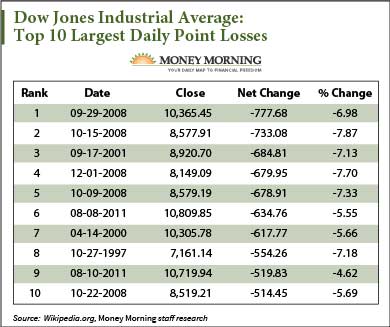 In 2008 alone, the DJIA suffered five out of its top 10 largest daily point losses in history - it sank 429 points in just five minutes on Sept. 29, after the U.S. House of Representatives failed to bail out $700 billion in bank debt. Shortly thereafter, the Dow plummeted 18% (1,874 points) in a week starting Oct. 6.
In 2008 alone, the DJIA suffered five out of its top 10 largest daily point losses in history - it sank 429 points in just five minutes on Sept. 29, after the U.S. House of Representatives failed to bail out $700 billion in bank debt. Shortly thereafter, the Dow plummeted 18% (1,874 points) in a week starting Oct. 6.
That same week, the S&P 500 index dropped 20%. It would fall a total 57% from its October 2007 peak of 1,565 points to 676 points in March 2009.
It wasn't just the stock market that plummeted:
- Housing prices fell 30% from their 2006 peak.
- The unemployment rate doubled from 5% (7 million Americans unemployed) pre-crisis in 2008, to 10% by the end of 2009 (15 million).
- And U.S. debt rose from 66% gross domestic product (GDP) to 103% from 2008 to 2012.
To blame was a systemic breakdown that encompassed Wall Street and Washington.
We like to call it the "Washington-Wall Street Corruption Corridor." The power players in politics and finance - some earning millions in salary and commission - together set into motion a stock market crash that wiped out more than $2 trillion of Americans' retirement savings.
And these ten players had key roles...
U.S. Stock Market Crasher No. 1: Angelo Mozilo
Mozilo served as cofounder and CEO of Countrywide Financial Corp. He's now widely regarded as the poster child of corporate misbehavior that led to the 2008 U.S. stock market crash.
You see, Countrywide sold millions of mortgages to homebuyers with less-than-pretty credit histories. In fact, it was the largest sub-prime mortgage lender in the country.
Besides convincing millions of Americans to purchase sub-prime mortgage loans, Mozilo greased the political wheel with "VIP programs" under which he offered certain politicians and government officials special mortgage rates.
His hard work paid off. Mozilo earned a reported $470 million in salary and other income during the housing bubble. He unloaded $141 million in Countrywide stock options prior to the company's share price collapse. While execs like Mozilo cashed out, the company's shareholders hemorrhaged - Countrywide investors suffered a more than $25 billion decline in market capitalization.
Mozilo didn't escape the crisis totally unscathed. On Oct. 15, 2010, he settled with the SEC for securities fraud and insider trading. He paid $67.5 million in fines - the largest settlement by an executive connected to the stock market crash.
Mozilo never admitted to any wrongdoing and was never pursued criminally.
Meanwhile, Bank of America Corp. (NYSE: BAC) acquired Countrywide in a fire sale in 2008 for $4 billion - a costly mistake. The bank paid a record-breaking $16.65 billion settlement in August 2014 over allegations it, via Countrywide, tricked investors into buying subprime loans.
U.S. Stock Market Crasher No. 2: Dick Fuld
In 2008, three of the largest American investment banks fell, and Lehman Brothers was the first to go. It filed for Chapter 11 bankruptcy protection on Sept. 15, 2008 - the largest in U.S. history at $613 billion in debts outstanding.
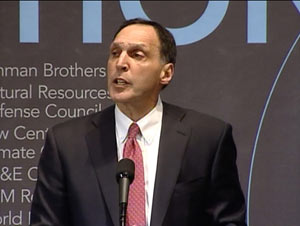 Dick Fuld, the "Gorilla" on Wall Street, was the man in charge when Lehman folded. He'd gotten the company into large positions in subprime mortgages. It even made its own subprime loans. Lehman passed on that toxic debt by the billions to investors in the form of bonds.
Dick Fuld, the "Gorilla" on Wall Street, was the man in charge when Lehman folded. He'd gotten the company into large positions in subprime mortgages. It even made its own subprime loans. Lehman passed on that toxic debt by the billions to investors in the form of bonds.
Once his methods began to unravel, Fuld failed to recognize his firm was in trouble and take steps to prevent it. He rejected offers from Warren Buffett and others to inject capital or merge. In a 2009 book A Colossal Failure of Common Sense, author Larry McDonald (a former senior Lehman Brothers trader) said Fuld required the firm's chief risk officer to leave the boardroom during key discussions.
In the first half of 2008 alone, Lehman's share value dropped 73%, and the company was forced to sell off $6 billion in assets.
Fuld, who'd earned a salary of $34 million in 2007, and $40.5 million in 2006, managed to save much of his wealth despite his bad behavior. For example, on Nov. 10, 2008, he "sold" his $13.75 million Florida mansion to his wife for $100 to protect his assets.
This next stock market crasher said it was a "mistake" to push people to buy housing they couldn't afford - but said it about five years too late...
U.S. Stock Market Crasher No. 3: Barney Frank
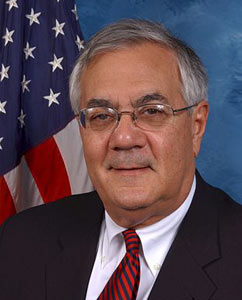 A democrat from Massachusetts, Barney Frank served in the U.S. House of Representatives for a quarter century from 1981 to 2013. He chaired the House Financial Services Committee from 2007 to 2011.
A democrat from Massachusetts, Barney Frank served in the U.S. House of Representatives for a quarter century from 1981 to 2013. He chaired the House Financial Services Committee from 2007 to 2011.
With his full weight of tenure, Frank became a banner advocate in Congress for bringing about lower underwriting standards in housing finance.
He imposed "affordable housing" requirements on Fannie Mae and Freddie Mac in 1992. The requirements forced the entities to meet government quotas when they purchased loans from banks.
In 2003, he remarked, "I want to roll the dice a little bit more in this situation toward subsidized housing." He pressed on when others began to have doubts, according Financial Crisis Inquiry Commission member Peter Wallison in an op-ed for The Atlantic.
While Frank was quick to blame others for the 2008-2009 U.S. stock market crash, he did make a small admission in an August 2010 interview.
"I hope by next year we'll have abolished Fannie and Freddie... it was a great mistake to push lower-income people into housing they couldn't afford and couldn't really handle once they had it."
U.S. Stock Market Crasher No. 4: Kathleen Corbet
Loan credit ratings are supposed to be a go-to risk metric for consumers deciding whether to invest.
But what consumers didn't know leading up to the subprime crisis was those ratings had been largely bought and paid for by the bond issuers themselves.
When it all came crashing down, investors who trusted AAA ratings were left with unsaleable CDOs and staggering losses.
Kathleen Corbet served as the president of Standard & Poor's, the largest rating agency, from 2004 until she resigned in 2007. In her tenure, top AAA ratings - which are meant to reflect low-risk - were given to extremely high-risk CDOs (collateralized debt obligations) that were essentially subprime mortgage-backed securities.
S&P and the other two largest credit rating agencies, Moody's and Fitch, together announced 4,485 CDO downgrades in Q1 2008 alone.
U.S. Stock Market Crasher No. 5: Phil Gramm
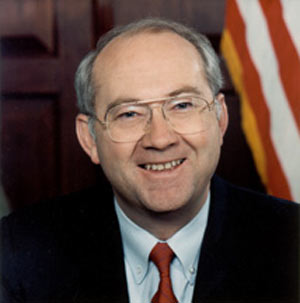 Phil Gramm managed to stay in Washington nearly his entire career. He began as a democratic congressman (1979-1983). Then he became a republican congressman (1983-1985), then a republican senator (1985-2002) representing Texas.
Phil Gramm managed to stay in Washington nearly his entire career. He began as a democratic congressman (1979-1983). Then he became a republican congressman (1983-1985), then a republican senator (1985-2002) representing Texas.
But Gramm really overstayed his welcome when he decided to start a lobbying firm in 1988. Through Gramm Partners, he spearheaded legislation in 1999 that's largely to blame for the U.S. stock market crash.
The Gramm-Leach-Bliley Act repealed portions of the Glass-Steagall Act - a post-Depression era law that regulated the financial services industry. He helped persuade former U.S. President Bill Clinton to sign the Gramm-Leach-Bliley Act into law in 1999.
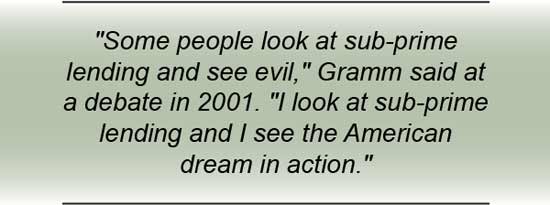
It'll come as no surprise that Gramm was the biggest recipient of campaign fund donations from commercial banks and in the top five for donations from Wall Street from 1989 to 2002.
U.S. Stock Market Crasher No. 6: George W. Bush
There's no getting around that this stock market crash happened on George W. Bush's watch.
In the beginning of his tenure, Bush did pursue tighter regulation of Fannie Mae and Freddie Mac, but was unable to convince Congress. Following the Enron scandal, he signed Sarbanes-Oxley into law, an Act that protects investors from fraudulent accounting activities by corporations.
But it wasn't all good. When SEC chair William Donaldson pushed to boost the regulation of hedge funds, Bush's advisors blocked him.
George W. isn't the only former president to blame. This is the one who set the crash wheels in motion...
U.S. Stock Market Crasher No. 7: Bill Clinton
Clinton's presidential tenure was a prosperous one. It saw the S&P rise 207.11% and the Dow 223.67%.
However, Clinton also set up the country for future failure with mass financial industry deregulation.
He signed the Gramm-Leach-Bliley Act into law (see No. 5 above) in 1999, which repealed portions of Depression-era solution Glass-Steagall. In 1995, he rewrote the Community Reinvestment Act, which pressured banks to give mortgages to people who may not be able to afford them. And Clinton signed the Commodity Futures Modernization Act, which exempted credit-default swaps from regulation. Credit default swaps, otherwise known as mortgage-backed securities, are the type of derivative that collapsed to trigger the Great Recession.
U.S. Stock Market Crasher No. 8: Henry "Hank" Paulson
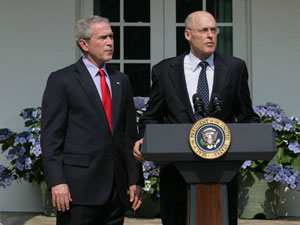 Another man guilty of letting the crash happen on his watch, former U.S. Treasury Secretary Henry Paulson proved the picture of naivety.
Another man guilty of letting the crash happen on his watch, former U.S. Treasury Secretary Henry Paulson proved the picture of naivety.
In April 2007, he spoke of a "healthy" and "robust" U.S. economy. "All the signs I look at [show] the housing market is at or near the bottom." In August the same year, he stated the subprime crisis was contained because of the strongest global economy in decades.
In May 2008, Paulson told The Wall Street Journal "I do believe that the worst is likely to be behind us." After Indymac Bank failed that July, he said "it's a safe banking system, a sound banking system. Our regulators are on top of it. This is a very manageable situation."
U.S. Stock Market Crasher No. 9: Alan Greenspan
Former Federal Reserve chair Alan Greenspan served from 1987 to 2006. His dislike for financial regulations and low interest rate environment set the stage for the 2008-2009 U.S. stock market crash.
An Oct. 15, 2008 article from the Washington Post accused Greenspan of having fought back against regulation of derivatives. He admitted he'd been "partially wrong" in that view in front of Congress on Oct. 23, 2008.
"Those of us who have looked to the self-interest of lending institutions to protect shareholder's equity - myself especially - are in a state of shocked disbelief."
American author and journalist Matt Taibbi, known particularly for his Rolling Stone article "The Great American Bubble Machine," said this of Greenspan's Fed: "Every time the banks blew up a speculative bubble, they could go back to the Fed and borrow money at zero or one or two percent, then start the game all over." Taibbi called Greenspan himself a "classic con man" (and worse).
U.S. Stock Market Crasher No. 10: Jimmy Cayne
Last but far from least, former Bear Stearns CEO James "Jimmy" Cayne was famously attending a 10-day bridge tournament in Nashville when two of his company's hedge funds collapsed in July 2007.
[epom key="ddec3ef33420ef7c9964a4695c349764" redirect="" sourceid="" imported="false"]
The CEO had gotten Bear Stearns deep into risky home loans. In the end, it held roughly $40 million in worthless mortgage bonds.
In March 2008, when Stearns was on the brink of bankruptcy, Cayne was in Detroit - again, for a bridge competition. While he was away, the Federal Reserve Bank of New York took emergency action to try to prevent Stearns' collapse by issuing an emergency loan. Still, the company failed. It was sold to JPMorgan Chase for $10 a share - $123.20 a share under its 52-week high.
Cayne was the first Wall Street CEO to own a company stake of more than $1 billion. In 2005, Forbes ranked him as the 384th richest American with an estimated net worth of $900 million. But Cayne lost 95% of his wealth when Bear Stearns collapsed. He'll go down in history for bridge-playing, golfing, and alleged drug use while his company tanked.
Tweet the author @TaraKateClarke to join the conversation.
Now, Some Money-Making Tips for Investors:
- Every investor is hard-wired to do three things that kill returns. Do you know how to avoid them? Find out what they are, plus the single-best investment strategy for maximum gains. Make 2015 Your Wealthiest Year Yet...
- In 2014, 33 million units of wearable tech devices were shipped. That number is expected to rise to 50 million this year. A select group of companies will capture these profits. Here are the wearable tech companies to keep your eyes on...
Related Articles:


